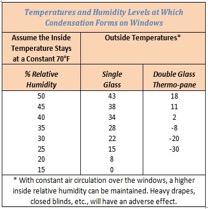So often this is our common complaint during the warmer weather. As living beings, we have been on the constant search for the perfect balance of being “not too cold and not too hot”, but relative humidity affects us much more than our personal discomfort of feeling sticky and dealing with bad hair days.
Several factors can play a role in our thermal comfort such as level of activity, amount and type of clothing we are wearing, radiant temperature, air speed and of course humidity. Recommended temperatures cited by CSA Z412-17 Office Ergonomics are 23-26°C in the summer and 20-23.5°C in the winter with an ideal relative humidity level of 50%. The gauge we are most familiar with in calculating humidity is the Humidex sent out with the weather reports.Humidex is a value created by combining the temperature and humidity in order to give an overall perceived value of how hot we feel.
When humidity reaches to about 90%, sweat evaporation (our body’s natural cooling system) can stop completely. Our preferences of temperature may vary from person to person but being in an environment that feels stifling with no relief can make anyone feel sluggish, nauseated and distracted. This creates lower performance productivity and even unsafe work practices due to intolerance and discomfort of the environmental conditions. Not to mention the increase of heat-related illnesses such as heat cramps, heat exhaustion and heat stroke.
Even though we as humans can feel almost immediately when humidity rises, our bodies aren’t the only thing that are affected by an increase in moisture in the air. Our physical environment can take on a great deal of stress from humidity too.
Signs of condensation such as sweating windows and beading glasses of juice created by humidity could be an indication that water vapor is also inside the walls. This can cause plaster to crack, general structural expansion and shrinkage, rotting wood or mold growth. Even in our efforts to combat humidity via air conditioning can increase condensation, especially if warm outside air is leaking in through say an exhaust fan.
There are many reasons why the measurement of humidity is so important.
As we have learned, one important reason is the effect that humidity has on our health. From the dangers and discomfort from high Humidex numbers and mold growth potential to the increased vulnerability for contracting a cold or the flu in very low humidity conditions.
In industry, the precision of humidity measurements become even more critical. Whether it’s the risk of rust and corrosion from condensation on delicate mechanical or electronic equipment components or the risk of electrostatic discharge damaging sensitive electronics components, it can be very important to know what the humidity levels are.
In a lab environment knowing the temperature and keeping it controlled within a narrow range is very important, but the same can be said for humidity. It was a common practice for most industry or lab environments to measure humidity conditions with a calibrated hygrometer with only a single point humidity measurement, but where humidity is not easily precisely controlled the value of the single calibration really is not appropriate. The demand for precise multipoint humidity calibrations has increased dramatically. Pylon has answered this demand by investing in a 2500 Thunder Scientific. Using the NIST proven, two pressure principle the Thunder Scientific is capable of generating humidity between 10% – 95% RH with an industry leading uncertainty of 0.5% RH. Pylon can now offer multipoint humidity calibrations with world-class accuracies.
The range of application is vast, from aerospace, medical and pharmaceutical laboratories, HVAC for controller environments, Heat stress monitoring and many more.
Contact a Pylon Calibration expert to ensure your humidity calibration requirements are being met.
Additional Resources:
http://climate.weather.gc.ca/glossary_e.html
https://www.ccohs.ca/oshanswers/phys_agents/humidex.html
http://www.ccohs.ca/oshanswers/phys_agents/thermal_comfort.html
http://fmlink.com/articles/humidity-in-buildings-how-is-it-affecting-your-building-and-its-workers
http://www.greenbuildingadvisor.com/humidity-mold-and-indoor-air-quality
http://healthliving.today/low-humidity-and-your-health
http://www.thunderscientific.com/tech_info/reflibrary/ncsl_paper.html







